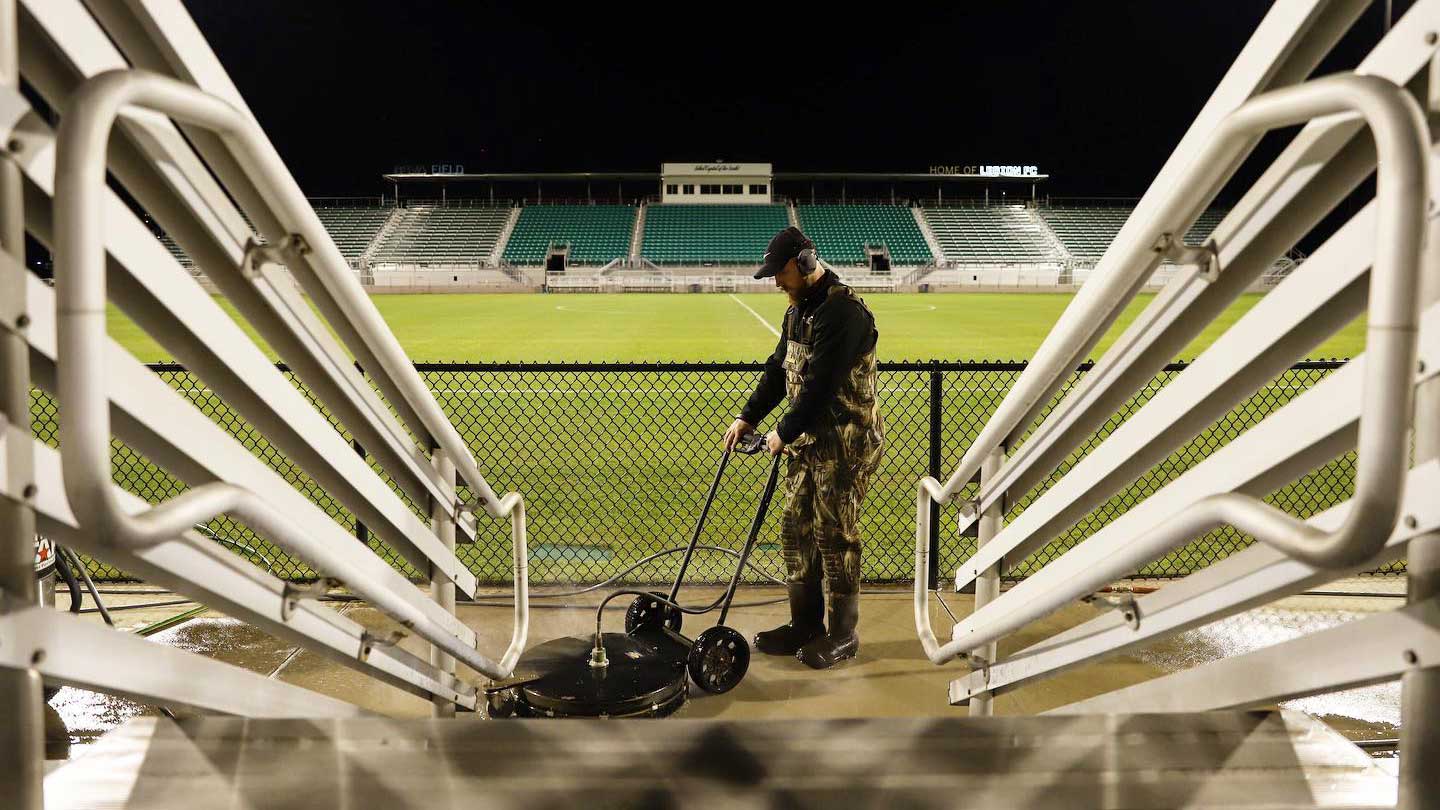
Sports stadiums and arenas are some of the most iconic and high-traffic structures in any city. Whether they host championship games, concerts, or community events, these venues face intense wear and tear—and that means they get dirty. Really dirty. 🤢
From food spills in the stands to gum on the walkways, from bird droppings on exterior signage to algae growing on concrete steps, it doesn’t take long for grime to build up. That’s where power washing comes in. 💪
In this article, we’ll explore why power washing is essential for maintaining stadiums and arenas, which areas benefit most, and how to get it done efficiently and safely. Let’s get into it! 🧼🏟️
🧽 Why Power Washing Is a Must for Stadiums
Power washing isn’t just for homes and storefronts. In fact, it plays a critical role in large-scale facilities like sports stadiums and arenas for a number of reasons:
✅ 1. Massive Foot Traffic = Massive Mess
Tens of thousands of fans can pass through a stadium during a single event. That means:
- Spilled drinks 🍻
- Ketchup and mustard stains 🌭
- Sticky soda residue 🥤
- Muddy footprints 🥾
- Chewing gum and trash 🗑️
All of that adds up—and if not cleaned properly, it creates an unhygienic environment.
✅ 2. Public Image & Brand Perception
Fans associate the look and feel of a stadium with the brand of the team or event. A dirty or neglected facility can reflect poorly on ownership, staff, and the organization as a whole. 👎
Clean bleachers, glistening walkways, and a fresh-smelling concourse contribute to a positive fan experience.
✅ 3. Safety & Slip Prevention
Stadiums with wet spills, mold, or algae growth on walkways or stairs pose a serious slip hazard. Regular power washing helps keep surfaces safe and slip-resistant. ⚠️
✅ 4. Structural Preservation
Left untreated, organic buildup like moss, algae, and mildew can cause erosion or staining of concrete, brick, and other porous materials. Regular washing extends the life of the infrastructure. 🧱✨
Browse Amazon Here For Top Rated Power Washers And Accessories
📍 Key Areas That Benefit From Power Washing
🪑 1. Seating Areas
Fans are messy. From spilled sodas to sticky foods, stadium seats and aisles accumulate a ton of grime. Power washing between events or during off-season keeps them clean and presentable.
🚪 2. Entryways and Ticketing Gates
These high-traffic zones see dirt, grease, and oil tracked in from outside. Pressure washing removes surface buildup and maintains a clean first impression.
🚻 3. Restroom Exteriors & Concessions Areas
Even if you clean restrooms internally, the exterior walls and walkways also collect grime. Power washing removes food stains, scuff marks, and sticky residue near concession stands and restrooms.
🧱 4. Concrete Stairs and Walkways
These areas are prone to algae, mildew, and dark foot-traffic stains. Pressure washing lifts the embedded dirt and restores the original appearance.
🏷️ 5. Signage, Statues & Exterior Facades
From rust to bird droppings 🐦, power washing is often the only way to clean tall structures and decorative elements without damage.
🧠 Special Considerations for Large Venues
Power washing a stadium isn’t like cleaning a driveway. Here’s what makes it unique—and how to plan accordingly:
🔋 Equipment Requirements
You’ll need commercial-grade power washers, often trailer-mounted or with water tanks for locations without easy hose access. For height work, boom lifts or scaffolding may be required.
🧪 Detergents and Degreasers
Use appropriate cleaners for different areas:
- Degreasers near food stations 🍔
- Sanitizing agents for restrooms and seating areas 🧴
- Eco-friendly solutions for public walkways 🌱
Always double-check runoff compliance with local wastewater laws.
🧯 Safety & Scheduling
For staff safety and crowd management, stadiums should only be power washed after hours, during off-days, or in the off-season. Early morning or overnight cleaning is common.
You may need to:
- Rope off areas being cleaned 🚧
- Ensure electrical systems are sealed or shut off ⚡
- Coordinate with security and maintenance teams
💼 Hiring a Power Washing Contractor vs. In-House
For larger arenas and professional sports stadiums, outsourcing to a professional power washing company is often the best move. Here’s why:
| In-House Staff | Power Washing Contractor |
|---|---|
| Limited equipment | Specialized tools & crews |
| Slower process | Fast, efficient completion |
| May lack safety training | OSHA-compliant & insured |
| Not always available | Flexible scheduling & emergency service |
A contractor brings expertise and equipment tailored to massive facilities. However, smaller venues like local gymnasiums or community sports fields may be able to handle this in-house.
📆 How Often Should Stadiums Be Power Washed?
- High-traffic areas like entryways and restrooms: Once a month
- Seating sections: After every major event or monthly during the season
- Exterior facades and signage: Twice a year
- Entire stadium deep clean: Annually during off-season
Of course, this can vary depending on the climate, the type of events hosted, and the stadium’s age.
♻️ Environmental Impact
Arenas located near water sources or in urban areas must take care to follow runoff and wastewater regulations. Eco-conscious cleaning practices may include:
- Using biodegradable detergents 🌱
- Capturing and filtering wastewater before it enters storm drains 💧
- Avoiding overuse of chemicals that can damage landscaping or nearby natural areas 🌳
Responsible power washing ensures you’re not just maintaining your stadium—you’re protecting the environment, too.
🏁 Final Thoughts
Sports stadiums are more than just buildings—they’re landmarks where memories are made. Whether it’s a touchdown, a home run, or a championship celebration, fans deserve a clean and welcoming place to enjoy the action. 🙌
With regular power washing, you’ll not only protect the infrastructure but also elevate the fan experience, maintain a clean and safe environment, and keep your venue looking professional and polished year-round.
Because in sports and in cleaning—performance matters. 💦🏟️
Browse Amazon Here For Top Rated Power Washers And Accessories



